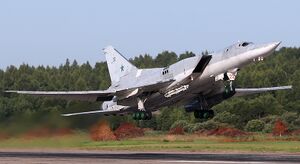AFSB-2 Spettro Strategic Bomber
This article is incomplete because it is pending further input from participants, or it is a work-in-progress by one author. Please comment on this article's talk page to share your input, comments and questions. Note: To contribute to this article, you may need to seek help from the author(s) of this page. |
| Vulcan AFSB-2 Spettro | |
|---|---|

| |
| A Cacertian Royal Air Fleet AFSB-2. | |
| Role | Strategic bomber |
| National origin | |
| Manufacturer | Vulcan Aeronautics |
| First flight | 4 November 1965 |
| Introduction | 11 October 1969 |
| Status | In active service |
| Primary user | |
| Produced | 1967—1997 |
| Number built | 231 |
| Unit cost |
ɫ283,500,000
|
The Vulcan AFSB-2 Spettro (Specter) is a supersonic, variable-sweep wing, long-range strategic bomber developed by Vulcan Aeronautics in the 1960s. Between 1969 and 1980, the AFSB-2 was operated by the CRAF as a missile carrier, strategic bomber, and long-range maritime anti-ship aircraft. In the modern era, the Spettro serves in the CRAF almost solely in the strategic bomber role as a result of changing dynamics in the Cacertian military. The Spettro first saw combat use during the FedCom Civil War in Knichus.
In 1996, 24 Spettros were sold to Ruvelka to fulfill the Imperial Air Force’s need for a supersonic, long-range strike craft. Pilots of the newly formed Ruvelkan 47th Heavy Bomber Aviation Regiment were sent to Cacerta and trained for several months to fly the Spettro. Once the purchase was finalized, the Spettros were flown on a direct flight from Cacerta back to Ruvelka refueling mid-air en route.
The Ruvelkans would later deploy their bombers in 2009 during the Zemplen War as part of Operation Eclipse, the controversial bombing raid that targeted infrastructure in Makedon and Galania. After losing three aircraft, Operation Eclipse was abandoned and the Spettros served in conventional bombing roles for the rest of the war.
Development
Design
Operation History
Variants
Operators
 Cacerta; Cacertian Royal Air Fleet—277 currently in inventory with the Royal Air Fleet.
Cacerta; Cacertian Royal Air Fleet—277 currently in inventory with the Royal Air Fleet. Ruvelka; Ruvelkan Imperial Air Force—21 remaining aircraft of the original 24 still in active service.
Ruvelka; Ruvelkan Imperial Air Force—21 remaining aircraft of the original 24 still in active service.
Specifications
General Characteristics
- Crew: 4 (pilot, co-pilot, navigator, weapon systems officer)
- Length: 42.46 m (139 ft 4 in)
- Wingspan: 34.28 m (112 ft 6 in) spread (20° sweep); 23.3 m (76 ft) swept (65° sweep)
- Height: 11.05 m (36 ft 3 in)
- Wing Area: 183.6 m² (1,976 ft²) spread (20° sweep); 175.8 m² (1,892 ft²) swept (65° sweep)
- Empty Weight: 58,000 kg (127,868 lbs)
- Gross Weight: 112,000 kg (246,918 lbs)
- Max Takeoff Weight: 126,000 kg (277,782 lbs)
- Max Takeoff Weight, Rocket-Assisted: 126,400 kg (278,664 lbs)
- Powerplant: 2 × VulAer ATE-1990 Afterburning Turbofans
- Fuel Capacity: 54,000 kg (119,050 lbs)
Performance
- Maximum Speed: Mach 1.88 (2,300 km/h, 1,400 mph) at altitude
- Range: 6,800 km (4,200 mi, 3,700 nmi)
- Combat Range: 2,410 km (1,500 mi, 1,300 nmi) with standard weapons load
- Ferry Range: 7,000 km (4,300 mi, 3,800 nmi)
- Service Ceiling: 13,300 m (43,600 ft)
- Rate of Climb: 15 m/s (3,000 ft/min)
- Wing Loading: 688 kg/m² (141 lb/ft²)
- Thrust/Weight: 0.45
Armament
- Guns: 1 × 23 mm cannon in remotely controlled tail turret
- Payload: 24,000 kg (53,000 lb) across wing and fuselage pylons and internal weapons bay
